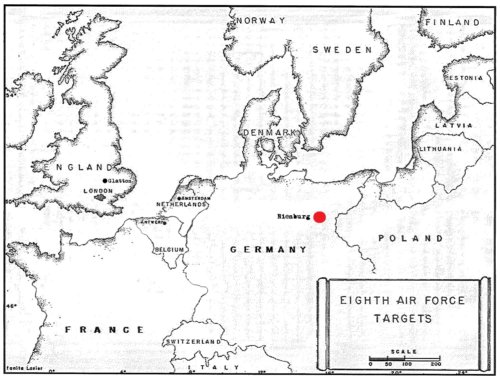TARGET: FUEL DUMP
NIENBURG, GERMANY
5 AUGUST, 1944
The heavy bomber effort was made by twenty-two combat wings against oil refineries, airfields, tank and aircraft production plants, and similar targets in north-central Germany. The 457th formed the 94th A Wing, flying ninth in the Division line and third on the target, which was a very large fuel dump about three miles south-southwest of Nienburg, Germany.
The Wing included three twelve-aircraft boxes. Major Hozier was Air Commander and Lt. Brannan was pilot. Crossing the North Sea and penetrating Germany on the coast, the Group flew southwest, passing between Hamburg and Bremen to Ulzen, then turned sharply southwest to an IP near Celle. The bomb run was made visually on the target, by all three boxes. In spite of clear weather, however, the three MPIs were hidden, for two wings of the 1st Combat Wing had struck first and smoke had arisen. The bombardiers used triangulation and dropped from 18,000 feet. There was no flak at the target.
Despite the fact that flak was encountered only once and then was meager, the group lost an aircraft. The aircraft piloted by Lt. Charles C. Canfield was hit after entenng the enemy coast. Two engines were completely shot out and Lt. Canfield turned back toward England. A fire broke out in the oxygen system just below the copilot’s compartment, which the top turret gunner- engineer extinguished by using his bare hands and some of the damaged fire-fighting equipment. The ship was over the North Sea when a third engine failed. The crew prepared to ditch and took their positions in the radio room. Lt. Canfield and Lt. Clarence E. Ross, the copilot, set the ship down in the North Sea. Utilizing the knowledge gained from previous training, the entire crew made their way out of the Fort and into their rubber dinghies. The plane had broken in half and sank twenty-five seconds after hitting the water.
Two P-5 1 Mustangs hovered overhead until the crew was in the dinghies, and they then proceeded on their way after radioing the position of the bomber’s crew. The crew was unable to use their radio in the dinghy, lest the enemy pick up their message, since they were only fifteen miles off the German coast. About three hours had elapsed when a British Air/Sea Rescue plane appeared and dropped a power boat to the crew. At the same time a fishing ship appeared and took the bomber’s crew aboard. The ship was a Danish fishing craft and the skipper, in broken English, told the American airmen he would take them to England. They started out for the English coast with the navigator aiding in the navigation of the ship.
Realizing as they neared British waters that there wasa great danger of hitting mines, Lt. Ross and Sgt. William R. Cain, the flight engineer, left the fishing craft in the power boat. They hoped to reach the coast and arrange for the Danish craft to make harbor safely. As Ross and Cain neared the coast, they were observed by a plane of the British Air/Sea Rescue, which radioed for a launch to pick up the two airmen. Another aircraft sighted the fishing ship and arranged for her safe passage into an English port.
